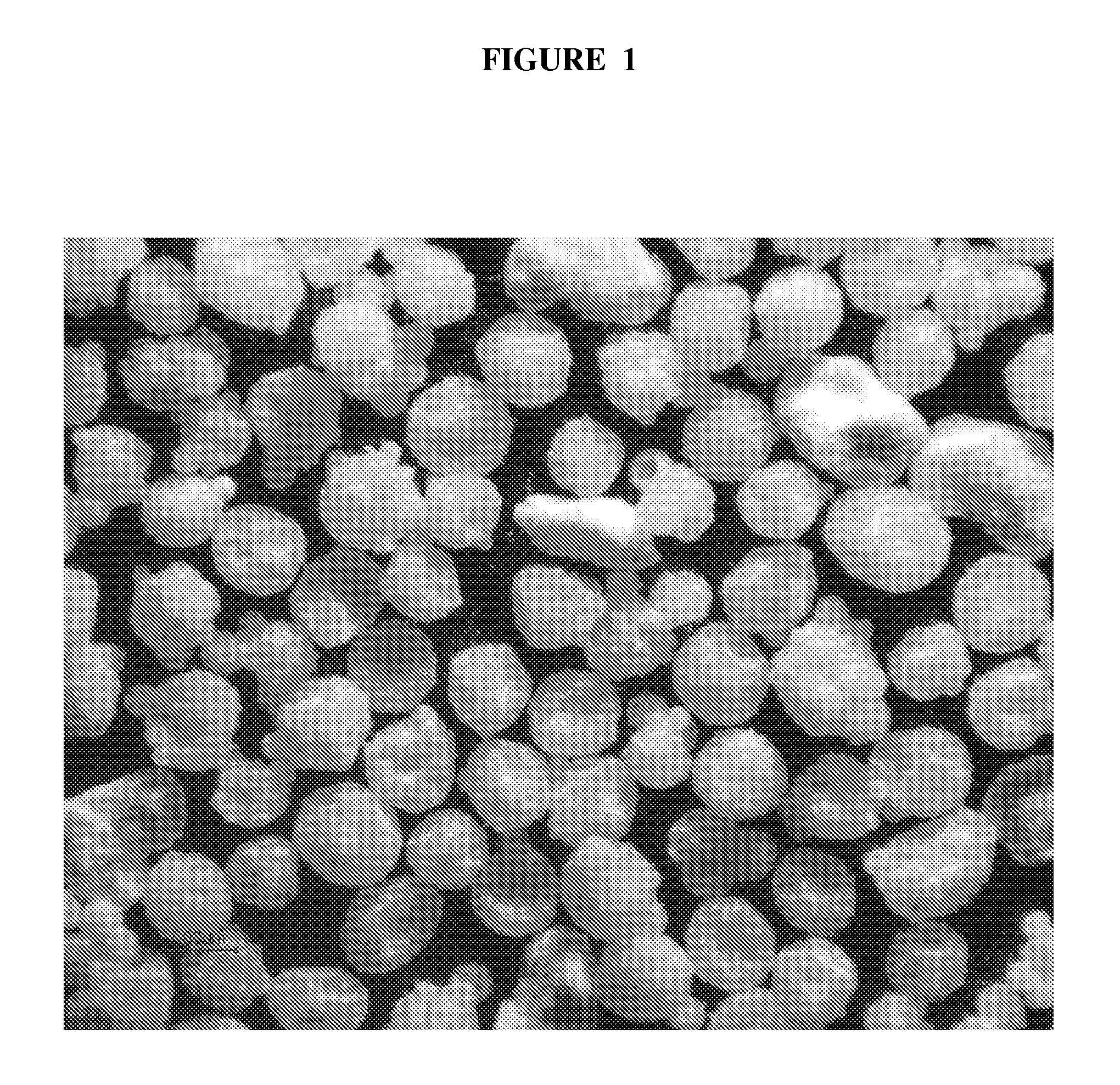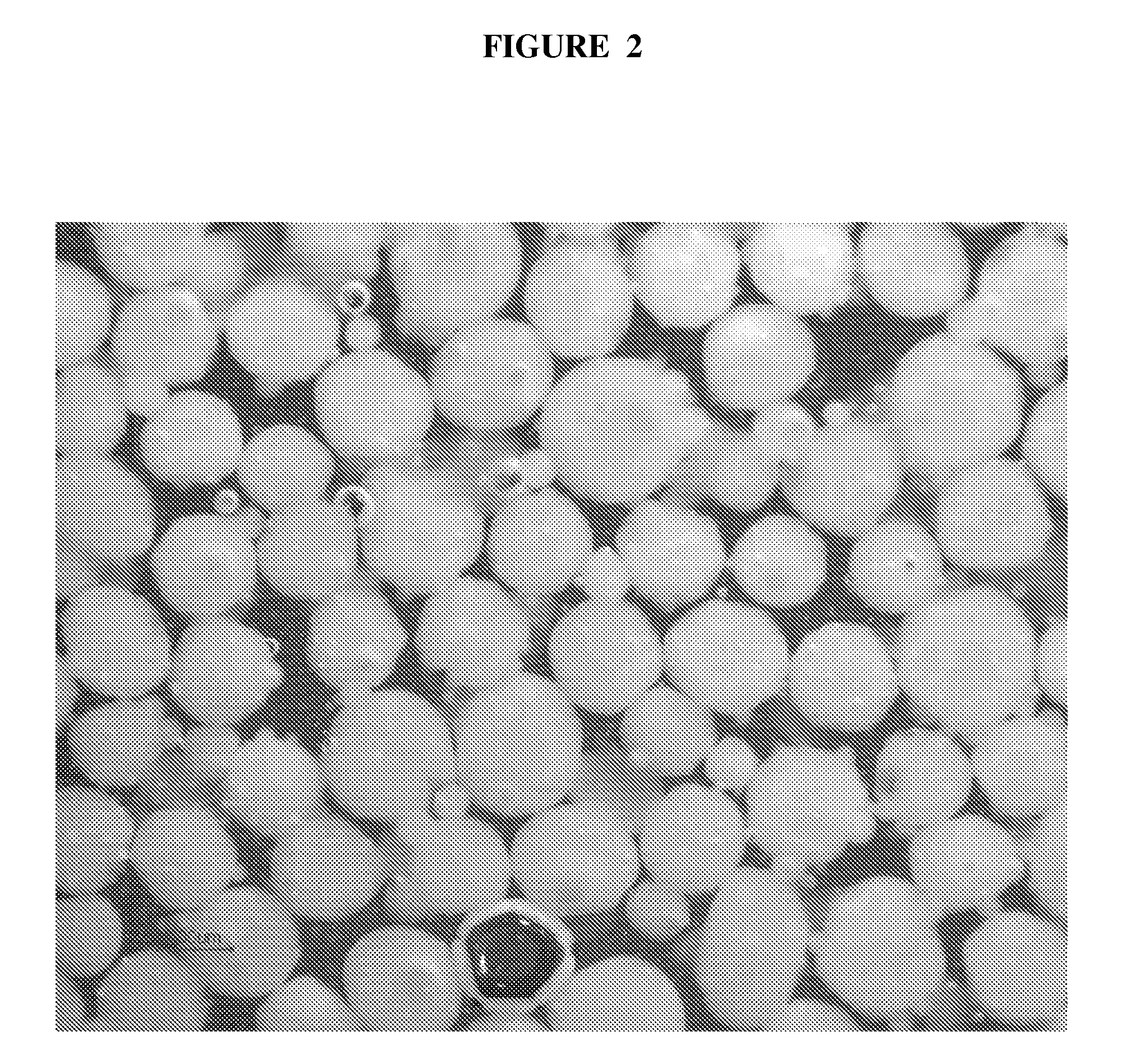One step spray-drying process
a spray-drying and capsule technology, applied in the field of capsule preparation, can solve the problems of large fluctuation, relative large particle size, and small particle size, and achieve the effects of low cost, high viscosity, and stickiness
- Summary
- Abstract
- Description
- Claims
- Application Information
AI Technical Summary
Benefits of technology
Problems solved by technology
Method used
Image
Examples
example 1
Preparation of Capsules Containing Limonene
a) Preparation of the Dry Anti-Caking Agent and Reactant Mixture Forming the Powdering Agent
[0125]250 G of native Starch type B from Roquette Freres SA were mixed with 150 g of dry Calcium Gluconate (Fluka) using a mechanical blender (HUG Maschinenbau, Switzerland). 0.4 G of fumed silica, Aerosil® 200 from Degussa were added to increase the flowability of the powder mixture.
b) Preparation of the Feed
[0126]65.5 G of modified starch (Capsul®, National Starch), 5 g of citric acid and 50 g sucrose were dissolved together into 1150 g of warm water (50° C.) using a dissolver disk until a clear yellow solution was obtained. 29.5 G of alginate (protanal LF10 / 60 from FMC Biopolymer) was then added until complete dissolution. 150 G of pure limonene were emulsified into the modified starch solution using an UltraTurrax® UT25 rotor / stator high shear mixer rotating at 23000 rpm for 2 minutes.
c) Processing Conditions
[0127]Inlet main air stream temperatur...
example 2
Preparation of Capsules Containing Limonene
a) Preparation of the Dry Anti-Caking Agent and Reactant
[0141]200 G of native Starch type B from Roquette Freres SA were mixed with 100 g of dry Calcium Gluconate (Aldrich 22, 764-1) using a mechanical blender (HUG Maschinenbau, Switzerland).
b) Preparation of the Feed
[0142]100 G of modified starch (Capsul®, National Starch), 640 g of maltodextrin 10-18DE and 60 g of pectin (Unipectine OF 305 from Degussa) were dissolved together into 1100 g of warm water (50° C.) using a dissolver disk until a clear yellow solution was obtained. 200 G of pure limonene were emulsified into the modified starch solution using an UltraTurrax® UT25 rotor / stator high shear mixer rotating at 23000 rpm for 2 minutes.
c) Processing Conditions
[0143]Inlet main air stream temperature=210° C.[0144]Inlet main air stream flow rate=75 Kg / h[0145]Fluidized bed air stream temperature=75° C.[0146]Fluidized bed air stream flow rate=24 Kg / h[0147]Fine return air stream temperature...
example 3
Preparation of Capsules Containing Limonene
[0158]The same processing conditions as those of Example 2 were used, except that the formulation contained a lesser amount of pectin.
Preparation of the Feed:
[0159]100 G of modified starch (Capsul®, National Starch), 680 g of maltodextrin 10-18DE and 20 g of pectin (Unipectine OF 305 from Degussa) were dissolved together into 1100 g of warm water (50° C.) using a dissolver disk until a clear yellow solution was obtained.
[0160]200 G of pure limonene were emulsified into the modified starch solution using a rotor / stator high shear mixer UltraTurrax® UT25 rotating at 23000 rpm for 2 minutes.
[0161]270 G of dry granules were collected in a glass vessel.
[0162]The final limonene load was also of 15% w / w based on the final weight of granules. Although the amount of pectin was much lower, the particles still jellified in warm water and the limonene droplets were trapped in a gelled matrix.
PUM
| Property | Measurement | Unit |
|---|---|---|
| Temperature | aaaaa | aaaaa |
| Temperature | aaaaa | aaaaa |
| Temperature | aaaaa | aaaaa |
Abstract
Description
Claims
Application Information
 Login to View More
Login to View More - R&D
- Intellectual Property
- Life Sciences
- Materials
- Tech Scout
- Unparalleled Data Quality
- Higher Quality Content
- 60% Fewer Hallucinations
Browse by: Latest US Patents, China's latest patents, Technical Efficacy Thesaurus, Application Domain, Technology Topic, Popular Technical Reports.
© 2025 PatSnap. All rights reserved.Legal|Privacy policy|Modern Slavery Act Transparency Statement|Sitemap|About US| Contact US: help@patsnap.com



